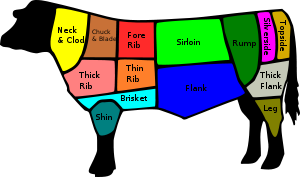The first time you apply a rub to a quality cut of beef, the experience can be intimidating. But our Arizona ranch families give some basic advice to ensure a great time in the kitchen or at the grill.
Kacie Tomerlin of Arizona Legacy Beef has spent lots of time cooking up quality beef. And no wonder. A fifth-generation Arizona Rancher, Kacie loves to cook and she love to cook their quality heritage breed of beef. So Arizona Farm Bureau ask Kacie about marinades and rubs for meat.
First, keep it simple and always use quality ingredients. “I find that the more simple marinades and rubs are the best,” says Kacie. “You want quality ingredients and you want to know why you’re using them. For example, you might decide to use plain sugar instead of brown sugar since brown sugar can sometimes overpower the meat or mask its flavor a good rub will have a balanced flavor that adds to meats but doesn’t overpower them. Keep in mind the four basic flavors when developing your own rub: salt, sweet, sour and bitter. A good basic rub to start with is equal parts sugar and salt and then flavor from there.”
Sometimes, you might be intimidated in trying a new marinade or rub. But Kacie suggests that rubs add to the fun of cooking. She also says that you start out by purchasing a less expensive cut of meat. “That way, if you make a mistake you’ve not done it with such an expensive cut of meat. Plus, cook with lower temperatures and therefore slower, this gives you a bit more corrective time.”
But how do you decide to marinade versus using a rub? “My rule of thumb is that I use marinades on less expensive cuts of meat and on cuts that are a bit tougher,” says Kacie. “I like using rubs for my more expensive cuts.”
A basic breakdown of tips for marinades and rubs is below. Also, Kacie has provided one of her favorite rubs for Tri-tip roast.
Marinating
- The marinade should totally cover the meat in order for it to work effectively.
- Soaking time: When using tender cuts of beef, the marinade is used basically to flavor the meat so a soaking time of 2 hours or less is all that is required. Tougher cuts of beef should be soaked in the marinade for several hours or overnight in order to tenderize the meat as well as flavor it.
- Refrigeration: Always marinate beef in the refrigerator.
- Proper containers: Since the marinade contains an acidic ingredient, reactive containers such as metal bowls should not be used. It is best to use containers such as glass or plastic bowls or plastic bags that can be sealed.
- Reuse: The marinade should not be reused for any other purpose because of the bacteria that may be present from having been in contact with the raw meat. The only way the marinade can be reused is to boil it thoroughly and then use it as a basting liquid or as part of a sauce for the meat.
Rubs
- A rub is exactly that, a rub. So apply the rub liberally to the meat using your hands, work it into the meat.
- Ingredients for a dry rub: Some of the ingredients that may be used for a dry rub include black pepper, cumin, chili powder, crushed red pepper, celery seed, garlic powder or fresh crushed or minced garlic, salt, sugar, and brown sugar.
- Paste rub: A small amount of liquid may be added to the mixture in order to create a dry paste, which may be preferred in some cases. Some of the liquids that are often used are vinegar, cider vinegar, wine, olive oil or Dijon mustard.
- Results: Both the dry rub and the paste will form a flavorful crust when the beef is cooked. Rubs are most often used with beef ribs that will be grilled or barbecued, but they can be used with almost any cut of beef.
Criollo Beef Spice
- 2 Tbsp Kosher Salt
- 3 Tbsp Strong Chile Powder
- 1 Tbsp Dried Granulated Garlic
- 1 Tbsp Ground Cumin
- 1 tbsp Coarsley Ground Black Pepper
- 1/2 Tbsp Ground Thyme
Directions
In a small bowl, combine all the ingredients, blending well to evenly distribute all the spices. Be sure to break up any chunks that form. Store the blend in an airtight container. Shake or stir it again before each use. Keeps for up to 3 months.
Side note: Kacie likes to rub the cut of beef with olive oil before applying the rub.
Special Fill Your Plate Offer: Go to www.fillyourplate.org and select our “blog” link. On the blog subscribe and you’ll be entered to win a free cookbook.
Related articles
- America….Prepare to Fill Your Plate (fillyourplate.org)
- Potatoes Pack a Powerful Punch in the School Lunch Debate (fillyourplate.org)
- The Buzz about Bees (fillyourplate.org)



